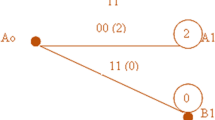Abstract
In this paper, we conduct stochastic modeling and analysis of the packet end-to-end delay in a multichannel selective-repeat automatic-repeat-request (MSR-ARQ) protocol. In this protocol, the transmitter continuously transmits packets over multiple parallel channels and retransmits erroneously received packets with either dynamic or static packet-to-channel scheduling policy. Under the assumption that packets are always supplied at the transmitter, denoted by the saturated traffic condition, we analyze the steady state probability distribution function of the delay of an arbitrary packet, which is measured by the duration between the instant at which the packet is transmitted for the first time and the time it departs from the resequencing queue at the receiver. Using the analysis result, we numerically compute the distribution function for chosen values of the number of channels and the error rates to demonstrate the computational effectiveness of the result. With numerical and simulation results, we then study the performance of MSR-ARQ in terms of the mean packet delay and compare the two scheduling policies. It is shown that the dynamic scheduling achieves a better packet delay performance than the static scheduling. With the dynamic scheduling and the presence of difference between the error rates of parallel channels, the mean packet delay decreases as the difference between channels’ error rates increases. Moreover, the number of parallel channels has an insignificant impact on the mean packet delay, which shows that the use of parallel channels is favorable for the wireless or mobile communications to increase the data transmission rate while keeping the mean packet delay at an acceptable level.
Similar content being viewed by others
References
IEEE Standard Group (2003). Wireless LAN medium access control (MAC) and physical layer (PHY) specifications: Amendment 4, Further higher data rate extension in the 2.4 GHz Band, IEEE Standard 802.11g.
IEEE Standard Group (2004). Air interface for fixed broadband wireless access systems, IEEE standard for local and metropolitan area networks, 802.16.
Bluetooth Special Interest Group (2006). WiMedia alliance ultra-wideband technology for high speed bluetooth applications. Available: http://www.bluetooth.org.
3GPP TS 25.321 V7.6.0, Medium access control (MAC) protocol specification (Release 7) (2007). 3GPP technical specification group radio access network.
Bahai A. R. S., Saltzberg B. R., Ergen M. (2004) Multi carrier digital communications: Theory and applications of OFDM. Springer, New York
Chang J.-F., Yang T.-H. (1993) Multichannel ARQ protocols. IEEE Transactions on Communications 41(4): 592–598
Chang R. W. (1966) Synthesis of band-limited orthogonal signals for multichannel data transmission. Bell System Technical Journal 45: 1775–1796
Ding, Z. (2006). ARQ techniques for MIMO communication systems. Ph.D. thesis, Department of Electrical and Computer Engineering, Brigham Yong University Provo.
Ding Z., Rice M. (2006) ARQ error control for parallel multichannel communications. IEEE Transactions on Wireless Communications 5(11): 3039–3044
Forkel I., Klenner H., Kemper A. (2005) High speed downlink packet access (HSDPA): Enhanced data rates for UMTS evolution. Computer Networks: The International Journal of Computer and Telecommunications Networking 49(3): 325–340
Fujii S., Hayashida Y., Komatu M. (2001) Exact analysis of delay performance of go-back-N ARQ scheme over multiple parallel channels. Electronics and Communications in Japan part 1 84(9): 27–41
Ghosh, A., Classon, B., Cudak, M., & Jalloul, L. A. Multi channel stop and wait ARQ communication method and apparatus. United States Patent No. 7,065,068. Available: http://www.patentstorm.us/patents/7065068.html.
Ghosh A., Wolter D. R., Andrews J. G., Chen R. (2005) Broadband wireless access with WiMax/8O2.16: Current performance benchmarks and future potential. IEEE Communication Magazine 43(2): 129–136
Hu, T., Afshartous, D., & Young, G. (2004). Parallel stop and wait ARQ in UMTS: Peformance and modeling. In Proceedings of the 2004 world wireless congress, San Francisco CA.
Jacobus, J. C. Multi-channel automatic retransmission query (ARQ) method. United States Patent No. 6,021,124. Available: http://www.patentstorm.us/patents/6021124.html.
Li J., Zhao Y. Q. (2009) Resequencing analysis of stop-and-wait ARQ for parallel multichannel communications. IEEE/ACM Transactions on Networking 17(3): 817–830
Li J., Zhao Y. Q. (2009) Packet delay analysis for multichannel communication systems with MSW-ARQ. Performance Evaluation 66(7): 380–394
Matloff, N. Introduction to discrete-event simulation and the SimPy language available: http://heather.cs.ucdavis.edu/~matloff/156/PLN/DESimIntro.pdf.
Redi, J., Watson, B., Ramanathan, R., Basu, P., Tchakountio, F., Girone, M., et al. (2006). Design and implementation of a MIMO MAC protocol for ad hoc networking. In Proceedings of SPIE 2006, Orlando, FL., Vol. 6248, 624802.1–624802.12, Florida, USA.
Shacham N., Shin B. C. (1992) A selective-repeat-ARQ protocol for parallel channels and its resequencing analysis. IEEE Transactions on Communications 40(4): 773–782
Sima M., Zhao Y., Zhang W. (2004) Joint selective repeat automatic repeat request (SR-ARQ) protocols based on multiple Markov channels. Journal of Shanghai Jiaotong University 38: 57–62
Wicker S. B. (1995) Error control systems for digital communication and storage. Prentice Hall, New Jersey
Winters J. H. (1987) On the capacity of radio communication systems with diversity in a Rayleigh fading environment. IEEE Journal on Selected Areas in Communications SAC-5(5): 871–878
Wu, W.-C., Vassiliadis, S., & Chung, T.-Y. (1993). Performance analysis of multi-channel ARQ protocols. In Proceedings of the 36th midwest symposium on circuits and systems (Vol. 2, pp. 1328–1331).
Zheng H., Lozano A., Haleem M. (2004) Multiple ARQ processes for MIMO systems. EURASIP Journal on Applied Signal Processing 5: 772–782
Author information
Authors and Affiliations
Corresponding author
Rights and permissions
About this article
Cite this article
Li, J., Zhao, Y.Q., Zhou, Y. et al. Packet Delay Statistics of the Multichannel Selective-Repeat Automatic-Repeat-Request. Wireless Pers Commun 66, 235–249 (2012). https://doi.org/10.1007/s11277-011-0325-4
Published:
Issue Date:
DOI: https://doi.org/10.1007/s11277-011-0325-4




